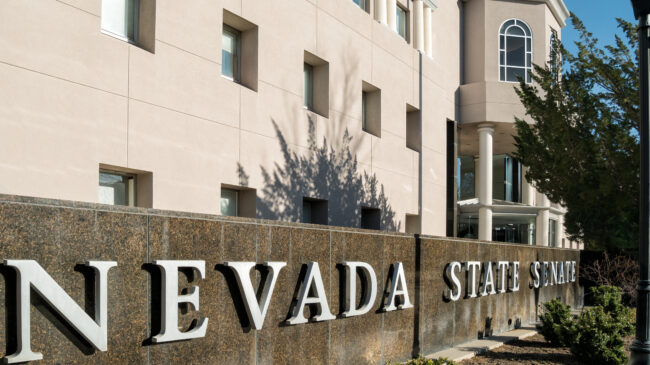Summary
The Nevada Legislature referred Question 1 to the voters as a proposed constitutional amendment appearing on the 2022 ballot. As a legislatively referred constitutional amendment, the measure had to be approved by lawmakers in two consecutive legislative sessions, and it would be ratified by gaining a majority of voters’ support in the November 2022 election. In 2019 and 2021, state senators approved the measure by a vote of 18-3, while the state assembly approved it by votes of 33-8 and 30-12, respectively.
Question 1 would enshrine a modified version of the federal Equal Rights Amendment (ERA) into the Nevada Constitution. The Equal Rights Amendment grew out of the suffrage movement from the early 20th century and was approved by the U.S House of Representatives in 1971 and the U.S. Senate in 1972. It proposed to amend the U.S. Constitution by inserting a clause stating, “Equality of rights under the law shall not be denied or abridged by the United States or by any State on account of sex.”
Although the proposed amendment was passed by Congress, it was never ratified by the required two-thirds of state legislatures to secure adoption. Only 35 state legislatures ratified the amendment ahead of the 1982 deadline, although the Nevada state legislature also ratified it posthumously in 2017 as a symbolic measure. Illinois and Virginia followed suit in 2018 and 2020, respectively.
Nevada Question 1 would expand the number of protected classes included in the federal Equal Rights Amendment from one to 10. Whereas the federal proposal included protections based on sex alone, Question 1 proposes to insert the following clause into Section 1 of the Nevada constitution:
“Equality of rights under the law shall not be denied or abridged by this State or any of its political subdivisions on account of race, color, creed, sex, sexual orientation, gender identity or expression, age, disability, ancestry or national origin.”
Fiscal Impact
No fiscal notes were submitted to Nevada lawmakers during the consideration of Question 1 as a legislative proposal.
Proponents’ Arguments
Advocates argue that Question 1 guarantees equality under the law for all persons, irrespective of personal attributes or superficial traits. They also argue that this amendment’s passage will send an important message about the values Nevadans espouse and could inspire others to follow suit.
As a legislative bill, Question 1 amassed five primary sponsors and seven additional co-sponsors. A majority of state senators from both major political parties voted in favor of the measure while the minority opposition included Democrats and Republicans as well. Organizations arguing in favor of Question 1 included the American Civil Liberties Union of Nevada, the Progressive Leadership Alliance of Nevada, the Nevada Women’s Lobby, and the Sierra Club.
Bill sponsor and State Senate Majority Leader Nicole Cannizzaro wrote of the proposal:
“The time is NOW to show the nation that we, as Nevadans, lead when it comes to equality for all. At every decision point in history, the quest for equality has met with stiff and obstinate opposition. Equal justice has NEVER been given. We must persist in this effort to achieve equal rights. There are nearly 30 states that have passed or are considering state equal rights amendments to their constitutions. Most provide for the equality of rights to not be abridged or denied because of sex. The measure before you today clarifies that the equality of rights should not only be based upon the sex of an individual, but on the wholistic aspects of all persons, which includes the mind, body, and spirit.”
Opponents’ Arguments
Opponents of Question 1 have argued that the proposal could lead to taxpayer-funded abortions, limit the ability of religiously affiliated colleges and universities to accept students who receive financial aid, and result in fewer opportunities for women. Organizations opposing Question 1 include the Alliance Defending Freedom, Nevada Families for Freedom, and the Pro-Life League of Nevada.
In written comments to the state legislature, Janine Hansen of Nevada Families for Freedom argued:
“In both New Mexico and Connecticut, courts used state Equal Rights Amendments to overturn restrictions on abortions and mandate taxpayer funding of elective Medicaid abortions with the rationale that since abortion is unique to women, restricting abortions is a form of sex discrimination.”
Hansen continued by claiming that Question 1’s inclusion of “gender identity or expression” as a protected class would enshrine biological males’ ability to compete in women’s sports and receive athletic scholarships and would “allow biological males in spaces previously reserved for women,” including shelters and prisons, and could threaten women’s safety.
Discussion
Equal rights amendments have been adopted into 25 state constitutions, although the majority guarantee rights based on: sex, race, color, creed, and, in fewer cases, religion. Delaware became the most recent state to modify or adopt an equal rights amendment in 2021 when it added “race, color, and national origin” to “sex” as protected classes. Nevada’s proposal is novel because it includes additional protected classes that do not appear in other state equal rights amendments, including “sexual orientation” and “gender identity or expression.”
Although critics have pointed toward cases in a few states where judges have concluded that a state equal rights amendment confers a right to taxpayer-funded elective abortions, those decisions pertain only to jurisprudence within the states where they were decided. It is unclear how that issue would be adjudicated under Nevada law.
Question 1 deals exclusively with the treatment of individuals by state and local governments, meaning that it could guide spending rules for state-administered public benefits programs, such as Medicaid, food stamps, or housing benefits, and could result in some individuals gaining newfound eligibility. However, it does not appear to require private businesses to expend capital on retrofits to facilities to accommodate the particular needs of any class.
A more fundamental question surrounding the proclaimed need for an equal rights amendment is whether the protections they would offer are already accomplished by the Equal Protection Clause within the Fourteenth Amendment to the U.S. Constitution. Adopted following the American Civil War, the Fourteenth Amendment states, in part: “No state shall…deny to any person within its jurisdiction the equal protection of the laws.”
Through the Supremacy Clause of the U.S. Constitution, this provision already extends to all states and supersedes any laws or practices that may conflict with the Equal Protection Clause.
Question 1’s advocates have argued that the Equal Protection Clause is insufficient because the U.S. Supreme Court did not apply it to prohibit discrimination based on gender until adjudicating Reed v. Reed in 1971. Although this is true, Reed v. Reed may have simply been the first opportunity for the Court to apply the Equal Protection Clause specifically to gender. The Supreme Court issued a unanimous opinion declaring the Equal Protection Clause’s applicability, however, and there are no major ongoing controversies over whether the Equal Protection Clause should be applied or withheld from any of the classes that Question 1 or other state equal rights amendments would purport to protect. As such, Question 1 and other state equal rights amendments may be symbolic, yet duplicative.

